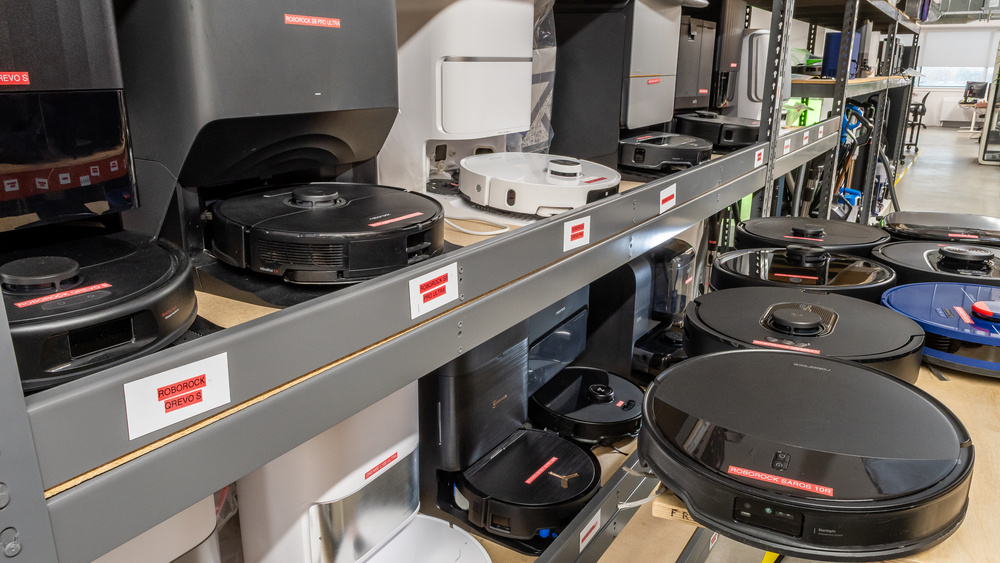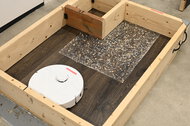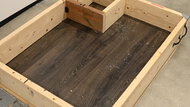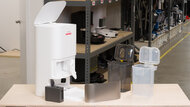If you don't have time to regularly sweep or vacuum, robot vacuums are an easy way to ensure your home stays clean without needing to do all the work. Since they use technology like lasers or cameras to navigate and maneuver around a room, they can avoid furniture and get beneath couches and tables relatively easily. Some of the best automatic vacuums can self-empty their dirt compartments, reducing the work you need to do. Although they aren't as good at cleaning carpets as more traditional upright vacuums, many come with smart pathing technology to clean more efficiently. Many also come with companion apps or remote controls to set up scheduled cleaning times or place boundaries to keep them out of certain areas. You've got more questions? Don't worry, we've got answers! Check out our FAQ below if you want to learn more about the intricacies of robot vacuums.
We've tested 80 robot vacuums, and below are our recommendations for the top robot vacuums you can buy. These picks are selected based on performance, feature set, design, and price. For more recommendations, look at our list of the best robot vacuums for hardwood floors, the best robot vacuums for carpet, and the best budget robot vacuums.
Quick Look


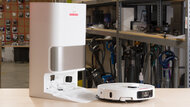


Our robot vacuum recommendations come from our independent testing of more than 80 different models. We purchase every robot vacuum we test, with no cherry-picked units or data. Every robot vacuum goes through the same suite of tests that covers everything from user maintenance to obstacle avoidance. Our testers and writers validate the results to ensure you can easily compare each model side by side, and we keep the products in our lab so we can continuously go back and retest them against the newest models.
Check out our How We Test Robot Vacuums article to learn more about our purchasing, testing, and writing procedures.
-
Best Robot Vacuum
 Multi-Surface Household7.9Debris Pickup: Hard Floor9.5Debris Pickup: Carpet6.7Obstacle Handling7.9Build Quality8.0User Maintenance6.5See all our test resultsRecurring Cost4.5
Multi-Surface Household7.9Debris Pickup: Hard Floor9.5Debris Pickup: Carpet6.7Obstacle Handling7.9Build Quality8.0User Maintenance6.5See all our test resultsRecurring Cost4.5The Roborock Saros 10R is the best robot vacuum cleaner we've tested. This flagship robot vacuum utilizes multiple solid-state LIDAR sensors for mapping and obstacle avoidance, as well as a camera for obstacle recognition, resulting in exceptional obstacle avoidance capabilities. The 10R can fit under very low furniture due to its low profile, as it doesn't use a top-mounted LIDAR tower. Additionally, it can climb tall thresholds thanks to the AdaptiLift system, which independently adjusts the height of its wheels. This robot vacuum also has an impressive mopping system. The multifunction docking station cleans the mop pads at a high temperature for greater sanitation and effectiveness, and it cleans its own mop pad wash tray. This eases daily maintenance tasks, leaving you to do more infrequent emptying, refilling, and cleaning of the dock's water tanks, as well as replacing the dustbag.
A split anti-tangle brushroll makes cleaning hair wraps in the robot vacuum a breeze, along with other small touches for easy cleaning and maintenance. Unfortunately, pet hair pickup isn't this robot vacuum's strength, as it struggles to remove hair caught deep in carpet fibers. This is due to its split brushroll design, which is great at resisting hair tangles but doesn't agitate the carpet sufficiently for the job. Like many robot vacuums, the 10R has numerous consumable parts, resulting in high recurring costs.
-
Best Upper Mid-Range Robot Vacuum
 Multi-Surface Household7.7Debris Pickup: Hard Floor9.0Debris Pickup: Carpet6.7Obstacle Handling5.6Build Quality8.0User Maintenance6.5See all our test resultsRecurring Cost4.5
Multi-Surface Household7.7Debris Pickup: Hard Floor9.0Debris Pickup: Carpet6.7Obstacle Handling5.6Build Quality8.0User Maintenance6.5See all our test resultsRecurring Cost4.5At an upper mid-range price point, the Roborock Qrevo Curv/Qrevo Edge is a good option. This former flagship is the predecessor to the Roborock Saros 10R and pioneered some of its technologies, like an extendable side brush and extendable mop pad, but it doesn't command flagship prices anymore. It has similar performance to the 10R, with outstanding hard floor pickup, reasonable carpet pickup, and excellent stain cleaning ability. The Curv and Edge variants feature differently styled docks with varying external dimensions, but share the same self-emptying and mop-washing capabilities to service the twin rotating pad mopping system, which is reused in the later 10R.
The dock takes care of much of the day-to-day maintenance, although it comes with its own set of periodic maintenance requirements, in addition to the regular robot vacuum maintenance tasks. The robot vacuum's two-part anti-tangle brushroll also helps since it resists hair wraps, making cleaning easier. However, it exhibits a similar disappointing performance to the 10R in pet hair pickup, making it a less desirable option for pet owners. The 10R also has newer technologies to get under low furniture or over tall thresholds, which you won't find in the older Qrevo Curv. Additionally, its previous-generation obstacle avoidance system means it will frequently hit or run over objects in a cluttered home, so you'll need to keep things neat and tidy if you want this robot vacuum to perform its job without requiring your intervention. Due to its numerous consumable parts and multifunctional dock, recurring costs are high with this model.
-
Best Mid-Range Robot Vacuum Cleaner
 Multi-Surface Household6.9Debris Pickup: Hard Floor7.5Debris Pickup: Carpet5.4Obstacle Handling8.7Build Quality8.0User Maintenance6.5See all our test resultsRecurring Cost4.5
Multi-Surface Household6.9Debris Pickup: Hard Floor7.5Debris Pickup: Carpet5.4Obstacle Handling8.7Build Quality8.0User Maintenance6.5See all our test resultsRecurring Cost4.5If you're looking to save even more and want a newer robot vacuum with new features, check out the MOVA P10 Pro Ultra. This is essentially a Dreame L10s Ultra with firmware tweaks and upgrades to certain systems, which improved its performance in our tests. It has a very advanced obstacle detection system and is even better than the Roborock Saros 10R at obstacle avoidance, so you won't have to clean before your robot vacuum can clean. Its full-featured docking station empties the robot vacuum, washes the twin mop pads with hot water for an effective clean, and dries the mop pads with hot air. This eases maintenance, though you'll still need to service the dock's water tanks and dustbag in addition to cleaning hair from the robot vacuum's brushroll and performing other tasks.
Hard floor pickup performance is good, but carpet pick-up performance is lacking since it doesn't use its side brush to clean edges and corners on carpet. Despite this model's lower price, recurring costs remain high due to its numerous consumable parts and multifunctional dock. For improved performance on carpet, consider the eufy E20. Even if you don't take advantage of its ability to convert into a decent handheld and stick vacuum, you'll appreciate its improved performance on hard floors, carpets, and pet hair. Obstacle avoidance is good, but it falls short of the MOVA's impressive performance in this regard, and you'll also have to give up mopping capability.
-
Best Budget Robot Vacuum Cleaner
 Multi-Surface Household5.6Debris Pickup: Hard Floor7.5Debris Pickup: Carpet6.7Obstacle Handling4.8Build Quality8.0User Maintenance6.0See all our test resultsRecurring Cost5.0
Multi-Surface Household5.6Debris Pickup: Hard Floor7.5Debris Pickup: Carpet6.7Obstacle Handling4.8Build Quality8.0User Maintenance6.0See all our test resultsRecurring Cost5.0If you're shopping for something marginally cheaper, the Wyze Robot Vacuum is among the best budget robot vacuums we've tested. Unlike more expensive options, this robot vacuum isn't compatible with a self-emptying base station; you'll need to manually empty its tiny dirt compartment at the end of almost every cleaning session. There's also no mopping capability. However, it still offers a range of features for the price. This includes a LIDAR sensor that enables quick and precise room mapping, even in dark environments, and you can utilize its companion app to set up virtual no-go zones or direct the vacuum to specific rooms.
Debris pickup on carpets is generally reasonable. It has no trouble dealing with solid debris and pet hair on bare floors; however, it can struggle with finer material embedded deeply within carpet fibers. As with any robot vacuum, regular maintenance is necessary to keep it in optimal condition. However, you may find removing hair tangled around the brushroll a bit challenging, as it tends to wrap around the bearings. Recurring costs are slightly lower than those of other models, as there's no multifunction dock; however, you'll still need to replace consumable parts on a regular basis. Note that this robot vacuum seems to be discontinued, but it's still available at one major retailer. You may have difficulty finding one, depending on your location.
Notable Mentions
-
Roborock Saros Z70:
The Roborock Saros Z70 is essentially a Roborock Saros 10R with a mechanical arm for obstacle removal rather than merely obstacle avoidance. It performs almost as well as the Saros 10R, but the mechanical arm reduces dustbin capacity and battery life. The mechanical arm itself doesn't perform very well and doesn't justify the enormous price increase.
See our review -
Dreame X50 Ultra:
The flagship Dreame X50 Ultra has better threshold climbing and obstacle avoidance systems than the Roborock Saros 10R but delivers worse hard floor pickup. The Dreame's low height clearance and mopping systems are also inferior to those of the Saros 10R.
See our review
Recent Updates
Nov 07, 2025:
We replaced the discontinued Roborock Qrevo with the Roborock Qrevo Curv, and the discontinued Roborock Q5 Max+ with the MOVA P10 Pro Ultra. We removed the Dreame L10s Ultra from our Notable Mentions since it's so similar to the MOVA P10 Pro Ultra, and we also removed the iRobot Roomba j7+ as a Notable Mention due to concerns about the long-term viability of the company.
Jul 03, 2025:
We replaced the Roborock S8 Pro Ultra with the Roborock Saros 10R as our pick for the 'Best Robot Vacuum' due to availability and better overall performance. We removed the aging iRobot Roomba S9 from the Notable Mentions and added the Roborock Saros Z70, Dreame X50 Ultra, and Roborock Qrevo Curv as alternatives to the Roborock Saros 10R.
Mar 13, 2025:
We added the Roborock S8 MaxV Ultra as a Notable Mention. We also made some minor text adjustments.
Jan 13, 2025:
Verified that all picks are valid and available. Small text changes for conciseness and clarity.
Oct 09, 2024: We've replaced the Roborock Q5+ with the Roborock Q5 Max+ as it performs better overall, and we've made some small edits for concision throughout the article.
FAQ
Can a robot vacuum fully replace a conventional vacuum?
Generally speaking, robot vacuums aren't a wholesale replacement for a full-size, manually operated machine. Most models on the market aren't powerful enough to deal with heavy debris or large piles of material, so you'll want to keep a conventional model on standby for bigger cleaning jobs. That said, robot vacuums have their market niche covered for "maintenance" cleaning; that's to say, frequent, low-intensity cleaning sessions that ensure there won't be a buildup of dust or lightweight dirt.
Are robot vacuums worth it?
Honestly, that'll depend entirely on your expectations, not to mention your budget. You don't necessarily need to spend a fortune on something that offers reasonable overall performance. Spending somewhere in the region of $200-$300 can net you a robot vacuum with LIDAR mapping, relatively advanced automation capabilities, and decent overall debris-pickup performance. A good example of this kind of option would be the Wyze Robot Vacuum. The above attributes are generally enough for most, as many models in this price bracket are quick to map out your home, smart enough not to get stuck too frequently, and powerful enough to deal with most messes.
If you want to spend less than that, you're likely looking at a robot vacuum with a rudimentary random-pathing bump navigation system, like the iRobot Roomba 694. These systems don't generate a coverage map of your home and aren't especially time-efficient. While they might achieve good overall room coverage, they're pretty slow in doing so and are far more liable to gett stuck on obstacles and clean the same area more than once.
Vacuums with mopping systems, real-time hazard avoidance technology, and self-emptying capability are generally pricier. None of these features are essential, but they're worth a shot if you don't feel like emptying a vacuum's dustbin, scrubbing away stains, or ensuring your home is completely free of any potential obstacles before letting it run. It's also worth noting that prices for these niceties are creeping down. Consider the Dreame L10s Ultra, which offers all of these aforementioned features for not much more than the more basic, stripped-down Roborock Q7 Max+.
How often should you perform maintenance on a robot vacuum?
Most manufacturers aren't shy about specifying how and how often you should maintain your robot vacuum, and it's worth noting that these maintenance intervals can vary pretty drastically from model to model. That said, there are a few things you can look out for, even outside of scheduled maintenance. You'll want to check the robot vacuum's brushroll once or twice a week to ensure no hair gets tangled in the mechanism; models with bristle rollers, as opposed to smoother rubber rollers, tend to collect a lot of pet hair. The same goes for side brushes and wheels; stuck-on debris can jam up their mechanisms, compromising overall performance. You'll also want to dispose of any material in the vacuum's dirt compartment.
However, it's worth noting that there are plenty of models on the market that come with docking stations that suck debris from the vacuum's dustbin into an external dirt compartment or dirtbag, so you won't have to go through the process of emptying a dustbin yourself.
Can I run my robot vacuum every day?
Absolutely! This is what most robot vacuums are designed for. Most models allow you to schedule cleaning sessions beforehand, so the vacuum will run while you're out and about.
How do I prepare my house for a robot vacuum?
You'll want to remove small obstacles like socks, slippers, or thicker power cords. While an increasing number of higher-end models, like the Dreame X50 Ultra, boast additional sensors that allow them to spot, identify, and, if necessary, avoid obstacles, these systems are still far from foolproof. You'll also want to remove any super-thick shag pile rugs because many robot vacuums can get bogged down in really plush carpet fibers.
If you have a robot vacuum with a LIDAR sensor, you'll also want to cover up any floor-to-ceiling mirrors before it maps out your home for the first time. The laser emitted from the vacuum will bounce off reflective surfaces, effectively causing the vacuum to 'perceive' a nonexistent room and even bump into the mirror itself. You can also get around this by setting up a 'no-go' zone around mirrors, at least on models that support this kind of function.
Conversely, if you have a robot vacuum that uses an optical sensor to navigate, like the iRobot Roomba i3, leave the light on in areas you want the vacuum to clean. Unlike LIDAR systems, optical sensor-based systems need a certain level of ambient light to navigate.
It's worth noting that many robot vacuums will also struggle with navigating on really dark-colored floors. Most models on the market have cliff sensors that rely on infrared radiation to work, and since dark surfaces absorb infrared radiation, this will trigger the cliff sensors and cause the vacuum to stop.
All Reviews
Our recommendations above are what we think are currently the best robot vacuum cleaners for most people. We factor in the price, feedback from our visitors, and availability.
If you would like to do the work of choosing yourself, here's the list of all our robot vacuum reviews. Be careful not to get too caught up in the details. While there's no single best option that's perfect for every use, most are good enough to please almost everyone, and the differences are often not noticeable unless you really look for them.
